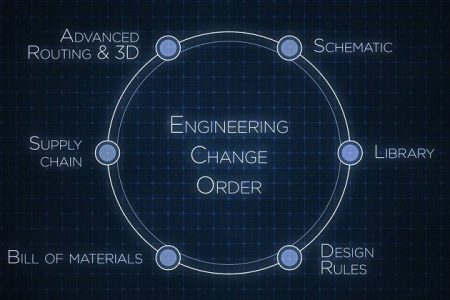Advantages of Designing PCB in 3D Environment. A few years back three-dimensional capabilities in a PCB design software were considered more of a beautification and not a necessity. However, with the evolution of PCB design software more 3D abilities and potential uses were added to the PCB Design Software which promoted 3D capabilities from being a ‘nicety’ to one of the vitalities in the PCB design environment.
Designing PCB in 3D Environment
If you happen to ask any PCB designer his preferable layout environment, the reply will be, of course, three-dimensional layout environment. If we talk about PCB Design Software, Altium Design Software is the one that has incorporated a full 3-D design environment as part of its core functionality; making it one of the most preferable PCB design software among the top printed circuit board designers. So, the question of the hour is as to why the three-dimensional environment is being preferred over two-dimensional? In this post, we are going to share with you certain critical advantages of working in a three dimensional PCB design environment.

Benefits of 3-D Printed Circuit Board Layout
- Prompt and Quick Visual Feedback
When placing components over a printed circuit board in the 2D environment, it is not possible to get an immediate visual feedback. As a result, a designer cannot see as to how the circuit board layer structure looks like. Hence, it is not possible to check out the interaction of the placed component with the components already placed over the printed circuit board.
However, when the same is being worked up in a 3-D design environment; a designer can detect immediately any sort of concern that may arise due to the placement of a particular component. As an example, it is not possible to detect shadowing concerns for all components in a 2-D design environment that may have a significant amount of effect on wave soldering. However, the same can be immediately accessed by the designer upon placement of the component, when working in the 3-D design environment.
- Helps in Accurate Placement of Component Silkscreen Outlines & Reference Designators.
A PCB designer, when designing a printed circuit board, must take care that the components, which are being placed, must not unknowingly overlap or cross over the reference designators. Along with this, a PCB designer needs to make sure that the components must not inadvertently overlap or cross over solder mask clearances as well.
Now, if a PCB designer has to check this impeccably and immaculately, 2D design environment won’t help at all. However, 3D design environment has changed the entire outlook of designing PCB. A 3D view enables the designer to tilt, rotate, pan and even zoom the image and as such it greatly helps in accurate placement of components so that they don’t overlap reference designators as well as solder mask clearances.
- 3D Design Environment Provides View of Both Electrical & Mechanical Design of the PCB
This is a vital benefit of working in the 3-D design environment. This enables the PCB designer to incorporate mechanical hardware as well, like screws, washers, and standoffs, while designing the PCB which helps the designer to make sure that there won’t be any kind of surprises when the time to mount the PCB will come
- 3D Design Environment Ensures Peaceful Assembly Process
When working in a 3D design environment, a PCB designer can, effortlessly, include the actual component models for connectors, LEDs, headers, switches etc. which greatly aids and assists in ensuring that when the printed circuit board is assembled, there won’t be any kind of errors. Moreover, a 3D design environment is useful to know that no interferences with the PCB components come up with inculcating mating connectors.
Conclusion
These are only some of the major benefits of PCB 3D design environment. As you can see, a 3D design environment makes it possible for the PCB designer to know beforehand itself whether any kind of error will come anywhere; right from PCB assembly to its installation. Thus, a PCB designer will have the know-how of errors at the design phase itself and hence he can work upon bringing improvements and modifications to his/her design so as to remove the possibility of the occurrence of those errors in the later phases. This ensures that a PCB is designed, assembled, manufactured and delivered in time and within the estimated cost.
